The Black Cat (1934)
Directed by: Edgar G. Ulmer
Written by: Edgar G. Ulmer, Peter Ruric
Starring: Bela Lugosi, Boris Karloff, David Manners, Julie Bishop
USA
AVAILABLE ON BLU-RAY: 2OTH JULY, in the THREE EDGAR ALLAN POE ADAPTATIONS STARRING BELA LUGOSI Boxset from EUREKA ENTERTAINMENT
RUNNING TIME: 65 mins
REVIEWED BY: Dr Lenera
Due to a mix up in reservations, Hungary-bound young honeymooners, Peter and Joan Alison, end up sharing a train compartment with a Dr. Vitus Werdegast, who claims that he’s travelling to see an old friend, Hjalmar Poelzig, and says that he lost his wife during the First Word War and spent fifteen years in a prison camp. A powerful storm causes their taxi to crash and they end up at Poelzig’s strange abode, which is built on the ruins of Fort Marmarus, the site of a bloody battle where Poelzig not only betrayed the fort to the Russians but stole Werdegest’s wife. Werdegast seems to want revenge….
Bela Lugosi’s favourite of his own films, The Black Cat is the jewel in the crown of the three films in Eureka’s set. It’s the first and bes of the eight films in which genre icon Lugosi would star with genre icon Boris Karloff. And it’s certifiably bonkers, so much so that [much like Bride Of Frankenstein which came later the same year], one wonders how on earth it got made in the Hollywood studio system of the 1930’s. The gloriously insane mixture of twisted relationships, sadistic revenge, sexual repression, Satanism, drugs and necrophilia [and more] lasts more than an hour yet is absolutely crammed full of images and scenes which you won’t forget in a very long time. In many ways it’s like Murders In The Rue Morgue, especially considering it was also heavily cut so that not everything makes sense. Even a cursory viewing would make it obvious that it was severely chopped up, but it’s a far, far more consistent movie than Universal’s previous Edgar Allan Poe adaptation; strikingly artistic, constantly on the verge of parody but continually aware of this, and though, as with many of these early Universal horror films [the ‘40s movies would generally be much faster paced], its initial slow pace may make it hard for some modern viewers to get into the film, it’s absolutely intriguing to study from scene to scene, and not least because it suggests so much perversity and touches on so much dark subject matter while not actually showing much on screen at all. I was virtually blown away when I first saw this prior to my older review of the film, and I couldn’t wait to see it again. Needless to say, it didn’t disappoint, even if the studio-created holes and inconsistencies in the bonkers tail were somewhat more obvious.
Director Edgar G. Ulmer’s first film, Damaged Lives, had been about syphilis, and had been understandably held up for release. Who knows why he was not just chosen by Universal to helm and co-write the script with Peter Auric for their second Poe’s adaptation, but was also given free reign. It’s possible that Carl Laemmle Jnr. produced it to wind up his father Carl Leammle who hated horror films. Publicity of the time claimed that Karloff and Lugosi were very competitive, but this wasn’t really true, even though Lugosi was nervous and jealous of Karloff, who’d become a bigger star than he and was paid double Lugosi’s salary, and was billed above him. Ulmer completed the film with no trouble; and then Universal saw the finished product. Details on the extensive re-editing aren’t that clear and in some cases vary depending on what source you read. Re-shoots certainly turned Lugosi’s character Werdegest from someone who is almost as insane as Poelzig to somebody more sympathetic, removed some gruesome shots like Poelzig crawling across the floor with his skin hanging off, and may have cut all of John Carradine’s footage as an explosives expert aiding Werdegest. Some have said that the Carradine footage was never filmed and was just in the original script, but Carradine mentioned it in an interview. This time, despite the strangeness of the picture even after the re-edits which the MPAA astonishingly passed uncut, Universal and Poe made for a commercial success, though as usual the critics weren’t enthralled. Various countries banned it and the UK release entitled House Of Doom cut seven minutes. Soon after its release, it was discovered that Ulmer had been having an affair with the wife of a producer who was the nephew of Universal studio head Carl Laemmle, leading to him being exiled from the major Hollywood studios.
Of course the opening titles show a black cat, then clips of the main characters while the dramatic music turns into a variant on Tchaikovsky’s ‘Romeo And Juliet’ as in Dracula and Karloff is billed as just ‘KARLOFF’. The interplay between our couple and the strange person they have to share their compartment with is so intriguing that I’d have been happy for these scenes to be three times longer. At first it all seems a bit like Universal’s The Old Dark House, with a couple forced by a storm to take refuge in a strange house populated by odd folk, though of course Werdegest is with them and he intended to go to Peolzig’s place of residence all along. Situated above, “the greatest graveyard in the world”, this place is intriguingly art deco, resembling more a Bond villain’s lair than a typical horror house, though John Mescall’s photography still reveals strange geometric patterns and beams in places they realistically could not be. Ulmer not only took inspiration from German Expression but based Poelzig on director Fritz Lang and named him after an architect who built the sets for The Golem. Karloff’s Poelzig gets a great entrance; first seen through curtains in silhouette, slowly rising from his head like a corpse while a woman under some kind of mental control lies beside him this wouldn’t have been allowed a year later], then appearing in full behind a slowly opening door. He immediately shows his lust for Joan by gripping the arm of a nude statue of a woman, while Werdegest demonstrates his fear of black cats by throwing a ruler at one, killing it. Then, in a wonderfully Gothic, not to mention perverse sequence, Poelzig wonders around a darkened room in which he has stored and preserved the bodies of female victims in glass containers. One is led to speculate as to what he does with these bodies, and it’s soon revealed he also has the body of Werdegest’s wife in similar condition, saying, “is she not beautiful? I wanted to have her beauty always”.
When Poelzig challenges Werdegest to a game of chess, any fan of old school horror probably feels like cheering, because Karloff and Lugosi have so much chemistry together and are clearly having so much fun. I wouldn’t have minded if the film had continued to focus on this game for the next ten minutes, but there’s a revenge plan in motion, albeit one which takes ages to come to fruition. Only when we learn of a certain revelation which hints at another major perversity [pay attention to the dialogue and make note of the time factor] followed by another terrible tragedy, does he go into action. In the finished cut, Werdegest is strikingly inconsistent. The way that the irony of Joan continually and wrongfully thinking that he’s a villain is threaded though the film is neat, but he gives the impression to us that he’s up to no good throughout too – which is what was originally intended. There seems to be a cut when one of the attendees at a climactic Black Mass [this was the first time one of those was shown in American cinema and it would be ages before one would be shown again] screams at something and thereby changes the course of the action; originally her horror was at the sight of Verdegest about to rape Joan. Did Ulmer and Ruric really have so little knowledge of what the censors of the time would allow? It seems that some supernatural material may have been removed too. When we usually see a black cat, we then cut to Jane, linking the two, and her personality changes when unconscious. Of course these and other unexplained hints of odd stuff just made the finished product even stranger, something highly irrational yet which perhaps follows some kind of dream logic – or maybe it doesn’t.
Ulmer admitted in an interview that Poe’s story was just credited to draw public attention, it had nothing to do with the plot of the movie. And yet Poe’s fascination with death pervades the whole piece, with even the dialogue constantly ramming it down our throats e.g. “we’re the living dead”, “the phone is dead” – though you can hardly say that it’s inappropriate. Our two antagonists are kinsmen even in the final cut, both terribly haunted by death and suffering. Is Poelzig’s building of a house on the very place where he betrayed thousands to their deaths, and his subsequent turning to Satanism, a way of confronting the demons brought up by what he did? In fact, he basically joins said demons. Another possible first for this film is that it looks at the concept of PTSD, illustrating how the trauma of war can change someone for the worst. We’re often reminded of the past events which set in motion the current ones, yet despite all this weighty and morbid stuff, the film still somehow remains true to its pulp elements; it’s still a cracking yarn, just an especially twisted one. There’s little outright comedy except for a very random bit where two policemen argue as to which of their home towns is better, but some may find a bit of dark humour elsewhere in the proceedings. And here’s yet another first; was this the first movie where a building contains a certain something [I won’t describe it so I don’t ruin the ending] which, if you think about it, seems silly but is always mighty convenient come the conclusion?
Karloff is on top form here. His performance almost comes across as a nastier variant on his role in The Mummy, certainly walking in a similar way as if he’s basically dead, and he really sends the chills down your spine every time he appears. Again he proves what an outstanding actor he was, refusing to ham it up, and able to suggest things like extreme sexual perversion with just a glance. Lugosi isn’t quite up to his level, but still fares well, especially in some lengthy speeches where he goes into his sad past, and is genuinely frightening when he finally goes more than a little mad near the end. With these two around having so much fun, Julie Bishop and David Manners [his third nominal ‘hero’ role for Universal] hardly have the chance to make much of an impression. One slightly annoying thing about The Black Cat is its score by Heinz Roemheld. In contrast to previous Universal horrors, this one has almost continuous music, though its themes are largely based on classical sources, just changing a few notes. It’s rather distracting to suddenly hear a bit of Schubert’s ‘Unfinished Symphony’ or ‘Beethoven’s Symphony No. 7’ just as you’re getting into a scene. The film would have probably been better off with no score at all. Nonetheless, for me, The Black Cat is a movie where I would kill to see its seemingly lost-for good-original cut as much as I would The Magnificent Ambersons, yet which is still pretty extraordinary in the version which did come out. It’s quite unique and absolutely fascinating from beginning to end.
Rating: 









The Black Cat looks only slightly less impressive than Murders In The Rue Morgue does in Eureka’s set. There are a few more specks, but the picture is just as sharp and detailed. The huge amount of black is handled with practically no trouble.
Again, the Eureka loses an audio commentary, and this time, two featurettes too, though they’re replaced by two others. Gregory William Mank returns from his fine Murders In The Rue Morgue commentary, and apart from two instances of referring to other talk tracks that were on the Region ‘A’ Scream Factory release which also contained The Raven and two other Lugosi and Karloff Universals Black Friday and The Invisible Ray, it’s an even better listen. Mank has collected together a huge amount of information on The Black Cat, some of it taken from interviews he held with David Manners and Jacqueline Wells [billed as Julie Bishop], the latter saying how she hated being in the film until she met Boris Karloff who she then developed a crush on. We learn that the opening train station footage came from 1932’s Rome Express, of the horrid mistreatment by Ulmer of Lucille Lund [Mary] when she spurned Ulmer’s advances, and where material was cut or re-shot, though there’s no mention of the removed footage featuring John Carradine and Wells which may of course be mythical anyway. Still, what a fabulous commentary! I’m rather disappointed that Mank won’t be talking about The Raven.
I don’t particularly like cats but I do find them fascinating, so Lee Gambin’s video essay Cats In Horror alerted me to a few feline features that I now intend to see. Nice to see the underrated The Uncanny get some positive words too, though Gambin sometimes seems to have to been asked to cram in too much. The Black Cat radio adaptation faithfully tells the Poe story with Peter Lorre in particularly enthusiastic form, plus much mention of Camel Cigarettes. How times change. And the vintage footage briefly shows Karloff and Lugosi, clad in their Black Cat garb, attending a bizarre promotion for the film involving young children[!] and just as many cats.
BOXSET SPECIAL FEATURES
*Limited Edition Set [2000 copies]
*O-Card Slipcase
*48-PAGE collector’s booklet featuring new writing by film critic and writer Jon Towlson; a new essay by film critic and writer Alexandra Heller-Nicholas; and rare archival imagery and ephemera
*High Definition Blu-ray [1080p] presentations for all three films, with The Raven presented from a 2K scan of the original film elements
*Uncompressed LPCM monaural audio tracks
*Optional English SDH subtitles
THE BLACK CAT
*Audio commentary by Gregory William Mank
*Cats In Horror – a video essay by writer and film historian Lee Gambin [12 mins]
*“The Black Cat” episode of radio series Mystery In The Air, starring Peter Lorre [26 mins]
*Vintage footage [1 min]
*Still Gallery
REVIEW OF ‘THE RAVEN’ COMING UP SHORTLY!

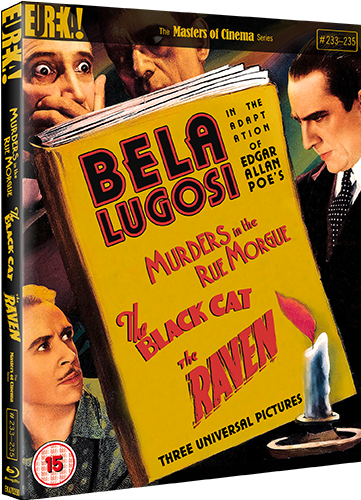
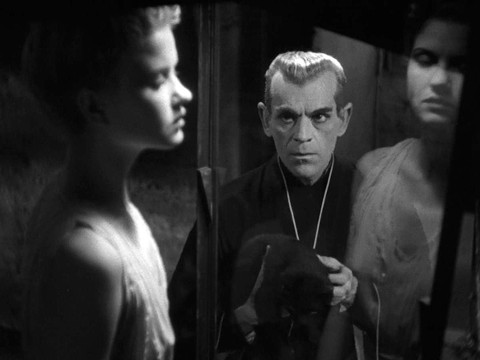
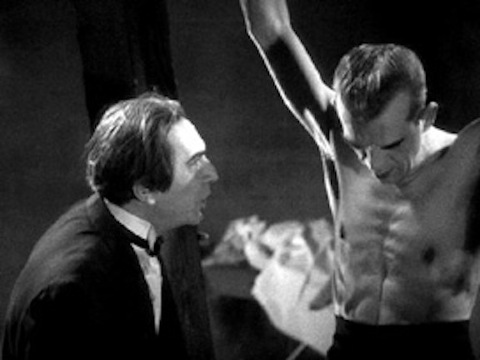


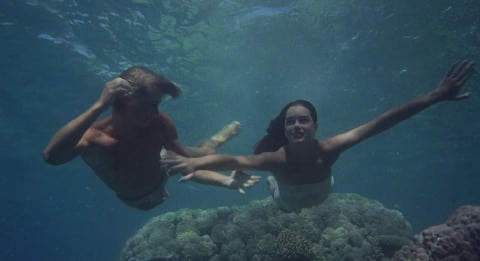
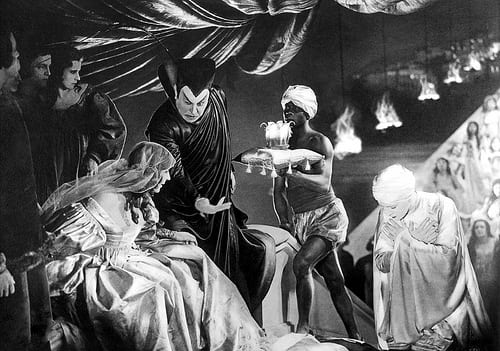
Be the first to comment